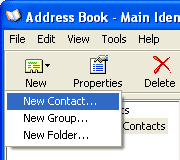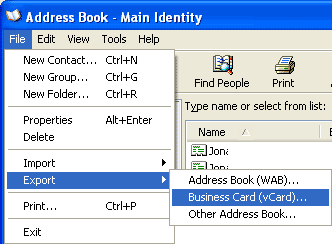Outlook Express address book to create a vCard
To create a vCard, we shall first be adding a new contact in the Outlook Express Address Book with all the information we want in the card and then have it exported in the required format. This article also provides a brief on vCards, the information you need to include in it and why all business people should you have one.
What is a .vcard file?
Though, I would like to believe that vCard stands for Visiting Card, in fact, its full form is Virtual-information Card. It is a standard file format to store contact information, usually business contact information such as company name, telephone and fax numbers, email and much more.
Sponsored Links
Since this is a standard file format it can be read by several programs and applications like mobile phones, email clients (Outlook Express) etc.
In this article I will provide step by step instructions on how to create a vCard file with your contact details using Outlook Express email client that comes with the Windows Operating system and the Internet Explorer web browser.
Fire up Outlook Express and open the Address Book by clicking on its icon or going to “Tools” > “Address Book” or the keyboard shortcut CONTROL-SHIFT-B. We would be employing the Address Book export feature to create the vCard file for us.
Adding your contact information to the Outlook Express address book
Click on the “New” button and select “New Contact” – refer image below.

This opens the Properties window in which we shall enter all the contact information. This window has 7 tabs – Name, Home, Business, Personal, Other, NetMeeting and Digital IDs. You can add as much information as you like, but typically people restrict themselves to the first three tabs.

Now go to each field and enter your particulars. This, as you can see, is pretty straightforward. However, one small piece of advice – make sure that the email you set as default is the one you check every day.
Once you are satisfied, click on the “OK” button. You shall see that your contact is now listed in the Address Book. Confirm that it is selected and then go to “File” option in the Properties window and click on “Export” > “Business Card (vCard)” – refer image below. What you are doing here is saving all your contact information in the vCard file format and make sure that you put it in an easily accessible directory such as the Desktop.

Why do I need a vCard file?
If you are in business even if it’s a small home based enterprise, I suggest that you create a vCard file with your contact details. A vCard file helps people add you to their address book with just a few mouse-clicks or key-presses and you can put a lot of information in this file (as we have seen above). Furthermore, since this file format is understood by most communication devices and applications, it can be used for a variety of purposes. For instance, you can attach it with your outgoing email and if the receiver wants to add your details to their address book, they can quickly. You can also put it on your web site or even send it over cell phone.






